Space and Exploration P1
1/89
Earn XP
Description and Tags
Grade 9
Name | Mastery | Learn | Test | Matching | Spaced |
|---|
No study sessions yet.
90 Terms
Frame of reference
A set of axes of any kind that is used to describe positions or motions of things
Celestial bodies
All objects seeing in the sky (e.g. sun, moon, stars, planets)
Constellations
Grouping of stars which form a pattern, which appear like objects
What did ancient people see?
They observed celestial bodies “moving” or “dancing” at night. They studied and many cultures created stories and legends about what they saw (mainly talking about European contributions but they are not the only one)
What is the turtle constellation?
Makinak
Makinak
The turtle constellation
The living calendar
Made up of 5 stars
Turtle shells have 13 pieces and there are thirteen months in Cree culture
Also aligns with the story of turtle island
What is geocentric view?
Aristotle proposed Earth must be the centre of the solar system, and all celestial bodies must orbit Earth. Earth was believed to be a perfect and divine sphere.
Retrograde motion
The apparent backwards motion of a planet in relation to the background stars- caused by Earth overtaking or being passed by another planet while in orbit.
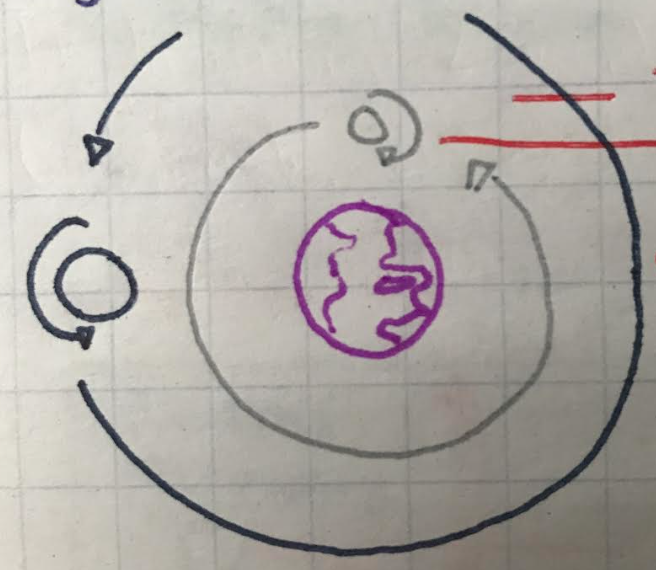
Explain the diagram
Geocentric model, planets orbit earth- the little spirals are what Aristotle used to explain why the planets looked like they were travelling backwards.

Explain the diagram
Heliocentric model, planets orbit the sun
What is heliocentric view?
Copernicus proposed the sun was actually the centre of our solar system
He struggled to support his hypothesis with evidence as scientific methods and technology were limited
Supported and refined by Galileo and Kepler
What is important for our observations?
Apparent daily motion was crucial for our observations and their explanations
Telescope
A device used to magnify objects at a great distance
Objective lens
The large lens at the end of the telescope
Ocular lens
The eyepiece of a telescope
When was the first telescope invented?
1608 in the Netherlands
What did Galileo do?
He made his own telescopes and began conducting experiments and observing the planets
He concluded that the speed of light is finite
Jupiter has many moons
He disapproved Aristotle’s ideas and supported Copernicus
Resolving power
The fineness of detail a telescope can produce of the object in view
How do you get better image quality in a telescope?
We can increase the resolving power by increasing the diameter of the objective lens (this is how we get more powerful telescopes)
Focal length
The distance from an optical system’s centre to it’s focal point- where light converges to form a sharp image
Bigger focal length=
thicker (bigger telescope)
Magnification=
Focal length of objective lens/ Focal length of eyepiece (O/E)
What is the problem with increasing magnification?
Increasing the focal length without using a larger diameter just gives us bigger, low quality image

Label diagram

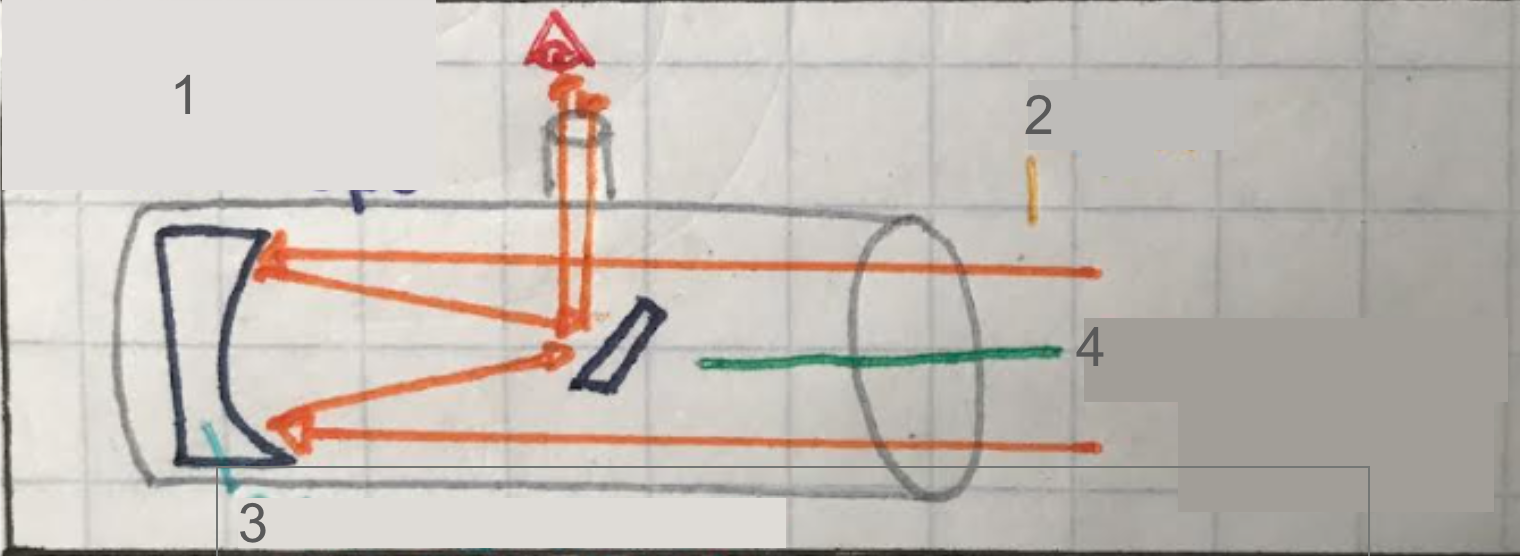
Label diagram
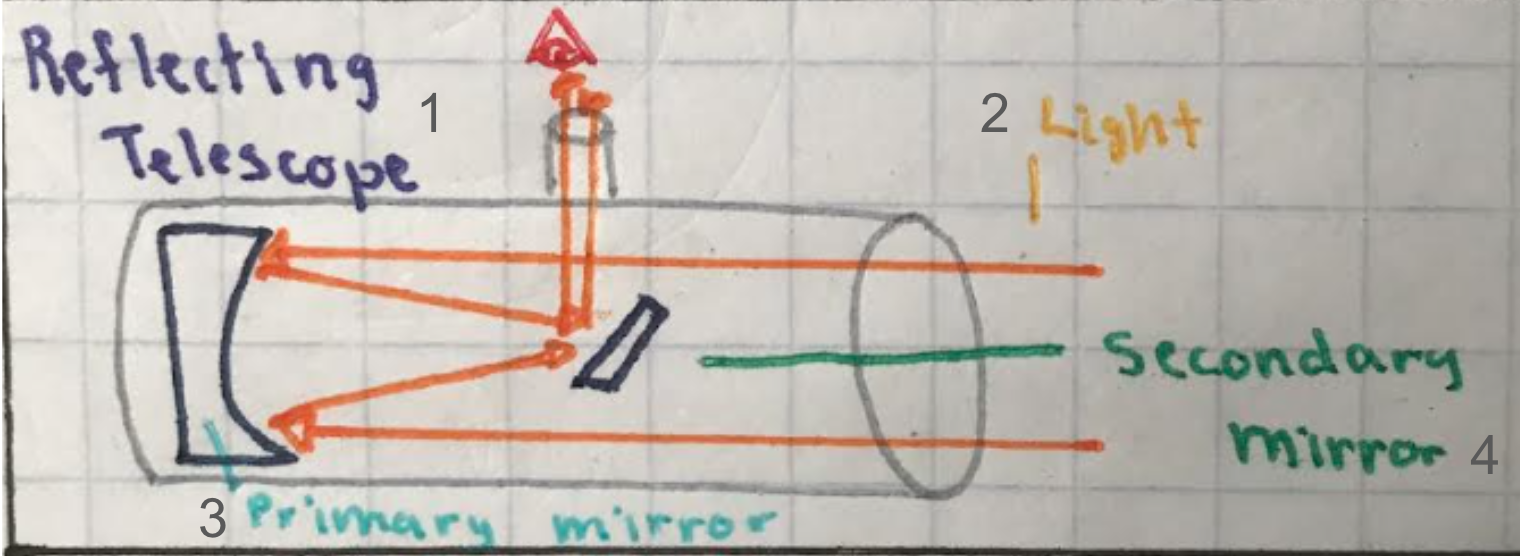

Label diagram
Combination telescope

Refracting telescope features
Objective lens- Light is redirected/ bent towards the eye
Pros- Higher resolving power
Cons- More mass, size is limited (not practical and heavier)
Reflecting telescope features
Objective mirror- Light is reflected/”bounced” towards the eye
Pros- Less mass
Cons- Less resolving power
Combination telescope features
Has both mirrors and lenses
Pros- Super duper powerful resolving power
Cons- Expensive, difficult to maintain/use
Optical
Using/detecting visible light
Adaptive optics
Techniques used to correct distortion from the atmosphere
How is the size limited?
The size of a telescope is limited by the mass of it’s components- and can affect resolving power
Interferometry
When we connect two or more telescopes with computers- raises the resolving power (we can simulate an objective the size of distance between the two)
Spectroscope
A device that produces a focused spectrum and can measure the exact wavelength of energy absorbed and re-emitted by various chemical elements (converts it to kinetic energy then back to visual)
When was the spectroscope created?
It was created by a German scientist in 1859- based on Sir Isaac Newton, he figured out passing sunlight through a prism created a spectrum of colours
How can we detect the chemical make up of a celestial body?
We can use the spectroscope
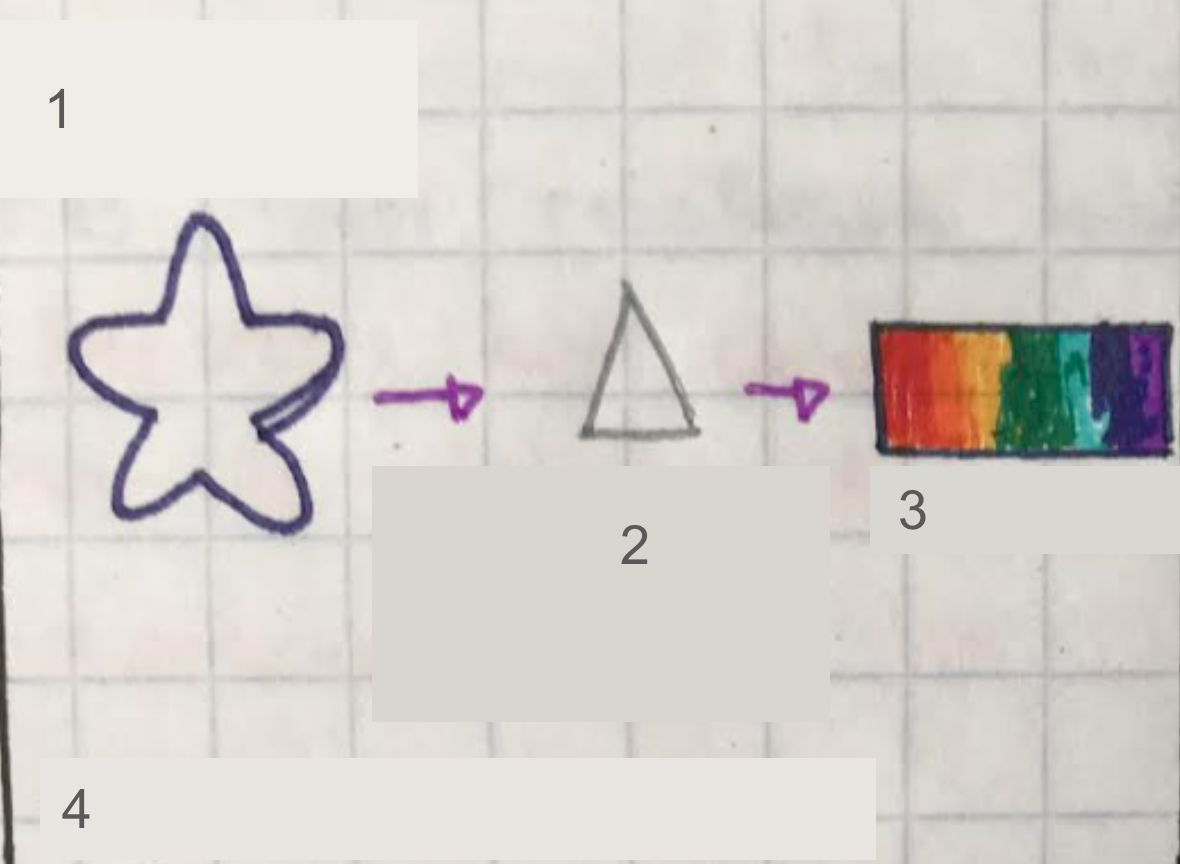
Label diagram
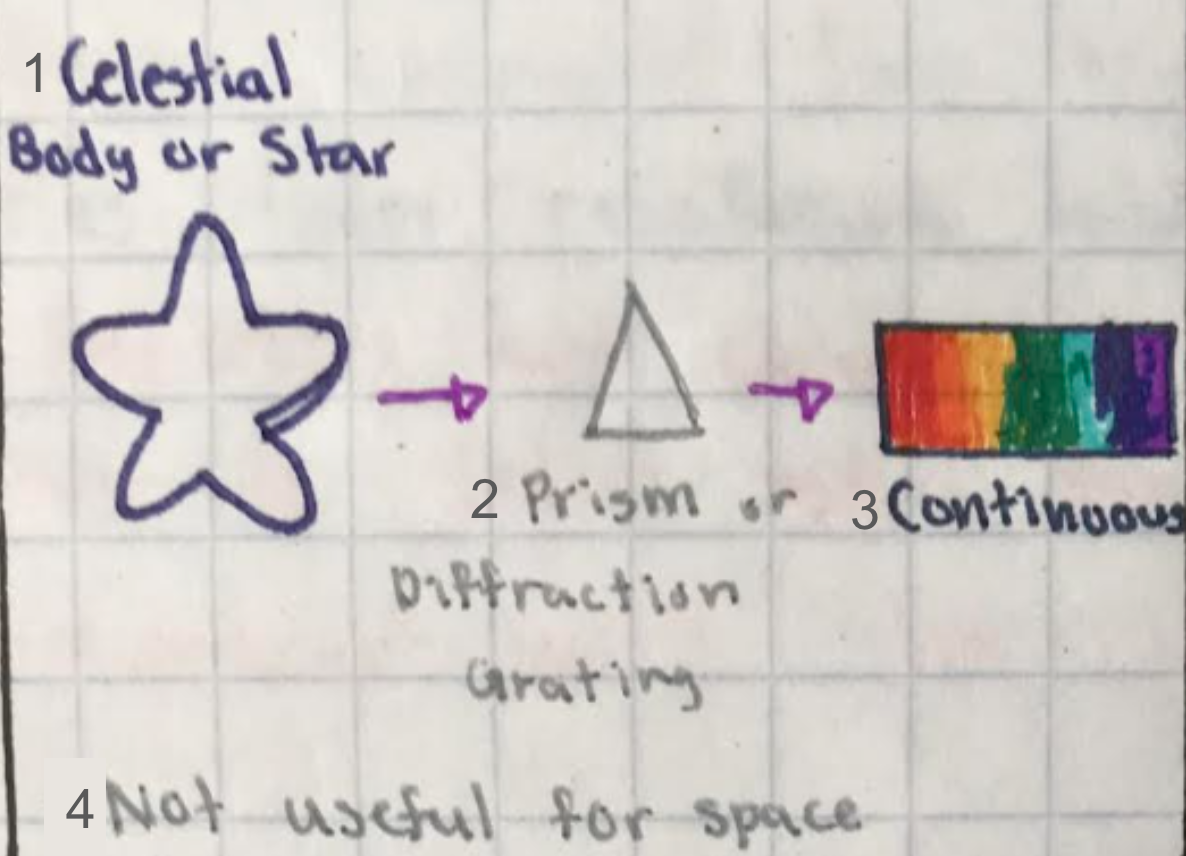
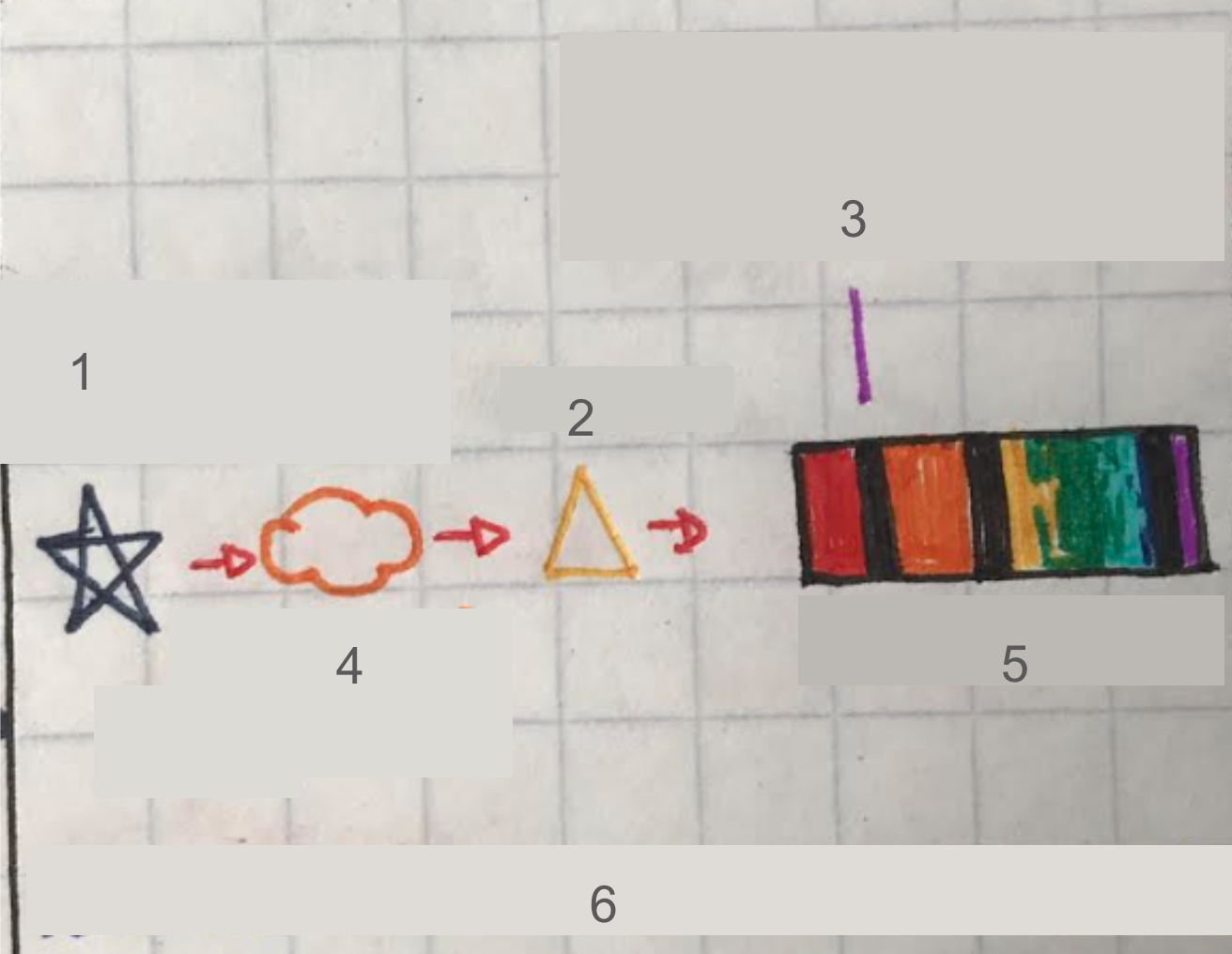
Label Diagram
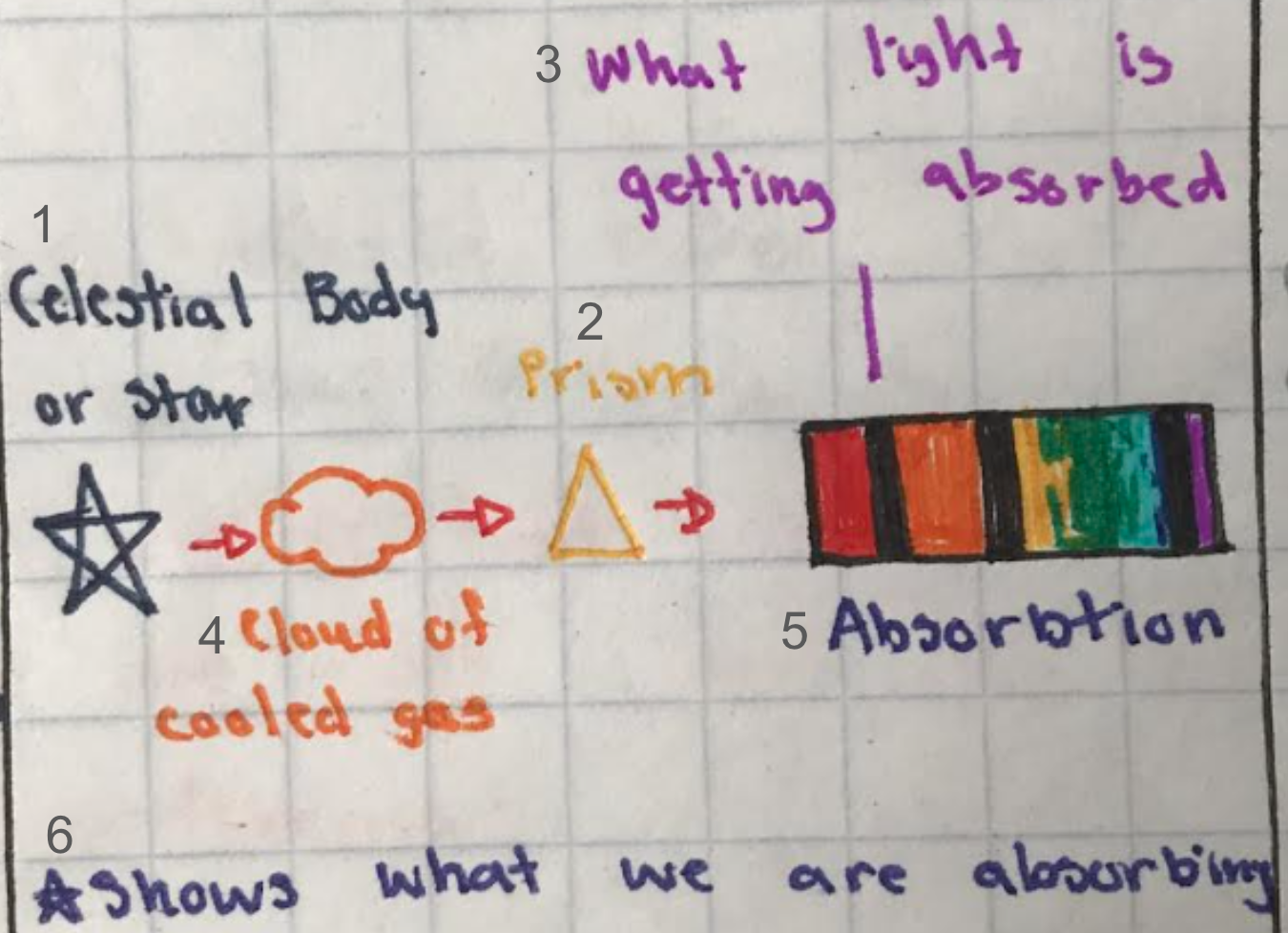

Label Diagram
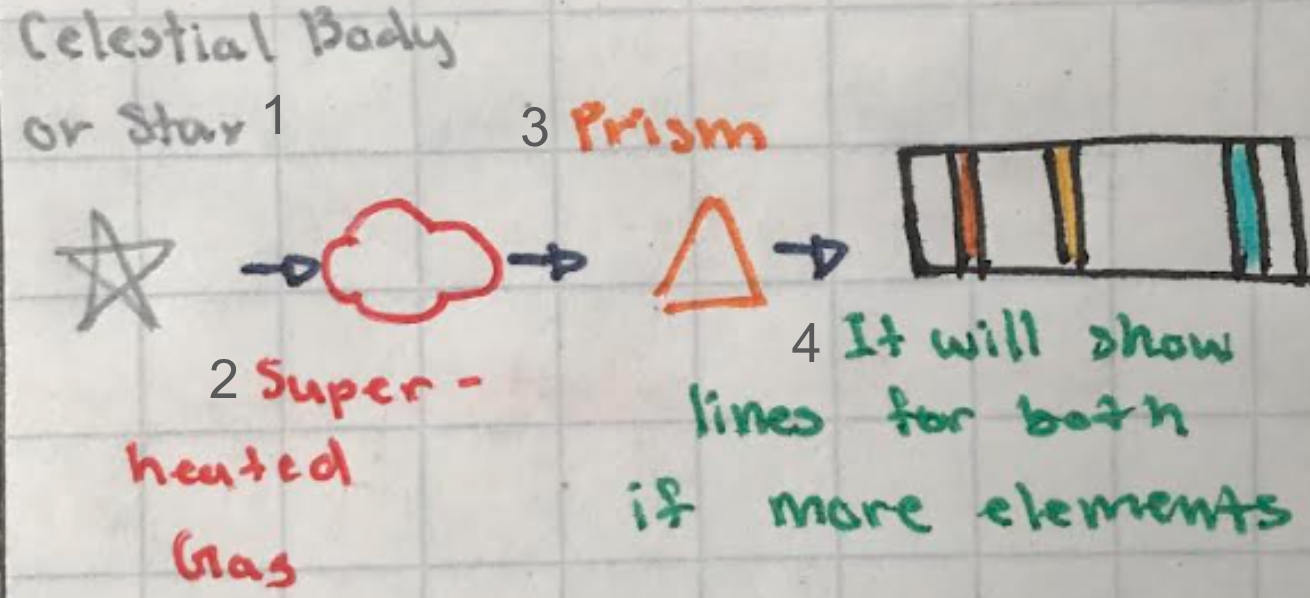
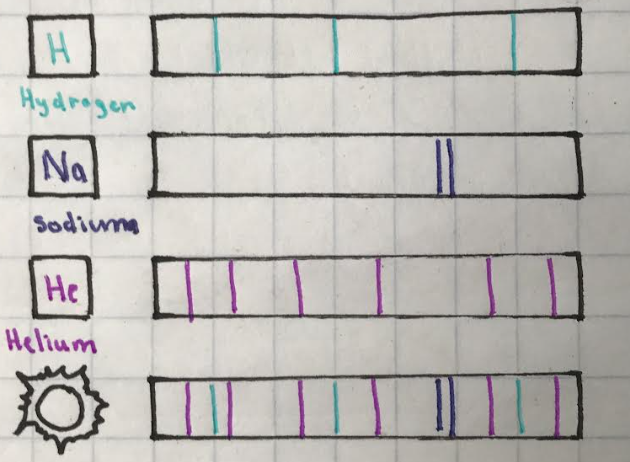
What does this diagram explain?
It shows what elements stars are made of based on their spectral lines (weaker lines show that there is less of a element in it- I didn’t show the weaker lines in the diagram)
Electromagnetic radiation
Varying types of energy waves emitted by stars

Label the diagram

Radio telescopes
Detect radio waves from celestial bodies
Has lower resolution and quality because waves are long and low energy
Penetrates dust clouds where visible light can’t
Able to detect bodies that are older, and they can detect through gas or atmosphere with low interference

Label the diagram

How far are Earth and Mars?
At their closest point Earth and Mars are 80 million km apart, they can be further though
How far apart is the sun and Earth?
150 million km
How far apart is the sun and Mars?
230 million km
Stars
Stars are massive balls of gas which release energy from nuclear fusion
The sun is…
The sun is the only star in our solar system
Inner planets
AKA the terrestrial planets
Mercury- Smallest planet, closest to the sun, barely any atmosphere
Venus- Hottest planet, thick CO2 atmosphere (traps heat)
Earth- In the Goldilocks zone, habitable
Mars- Most habitable planet after Earth, has ice (water) and is close to Earth
Outer planets
AKA Jovian Planets
Jupiter- Largest planet, has the “red spot” a giant atmospheric storm
Saturn- Large planet, famous for it’s rings
Uranus- Blue, turns on it’s right side
Neptune- Blue, has many storms
Galaxy
A system of stars, dust and gas held together by gravity
Which galaxy do we live in?
The Milky Way
Sun
Is a star
Largest celestial body in our solar system
Source of energy
Made of hydrogen
What is the difference between Earth’s atmosphere and other planets?
Earth’s atmosphere is habitable, while the other option is Mars though it has a thin atmosphere- not ideal for temp regulation
What is the difference between Earth’s temperature and other planets?
Earth is in the Goldilocks zone (15℃- 20℃) while Mars has a variable temperature (-153℃-20℃) but also has seasons like Earth
What are the other possibilities other than planets to live on?
Moons, mainly Jupiter’s and Saturn’s.
Atmosphere- Titan
Temperature- Europa
The only reason we don’t consider those as much as Mars as they are too far away
What is the difference between the Inner and Outer Planets?
The inner planets are rocky, solid, have no rings, have 0-2 moons and are smaller. The outer planets are gaseous/liquid, have many moons and rings (in general).
How many moons does Saturn have?
Saturn has 274 moons
Asteroids and meteors
Found mostly in the asteroid belt
Made of rock, metal (meteoroids)
Meteors have a tail of light
Asteroids are bigger than meteors
Meteorite → Meteoroid after it passes through the atmosphere, breaks apart
Comets
Dirty ice-balls
When they near the sun they heat up and leave a visible tail of shedded ice and gas
Bigger than both asteroids and meteoroids
Jupiter spins on its axis ______ than Earth does, and it has an orbit that is ______ than Earth
Jupiter spins on its axis faster than Earth does, and it has an orbit that is larger than Earth
What part of the universe have the largest diameters?
Galaxies
Why is the image in a telescope enlarged?
The image is enlarged because light entering it is refracted and converged by the lenses (refracting telescope)
What does a spectral analysis do?
It helps determine the chemical composition of a star
Flame spectroscopes help with?
With determining the chemical composition of stars
Optical telescopes help us?
Observe far-away celestial bodies
When is using a telescope with an ocular lens of 25mm and an objective focal length of 1200mm, the magnification will be:
1200mm/25mm= 48 (Division not multiplication)
What do you need to do to increase the magnification of a telescope?
You need to increase the diameter of the objective lens
The Doppler Effect
The apparent shift in the frequency of the wave caused by the relative motion of the source of the wave compared to the observer
What happens if the wavelength is shorter as a sound?
It would seem to have a higher-pitched frequency
What happens if a wavelength is shorter as visible light?
It would seem more blue in colour
How can you tell if stars are moving?
When a star is moving, it’s spectrum (recall emission and absorption) will shift depending whether the waves stretch (moving away) or compress (moving closer)
Why are most things red-shifted?
Because the universe is constantly expanding
Stationary
What we would normally expect to see from a spectrum in a lab- not in motion
Red-shifted
All lines are the same but shifted towards the red/lower energy end of the spectrum
Blue-shifted
All lines are the same but shifted towards the blue/higher energy end of the spectrum
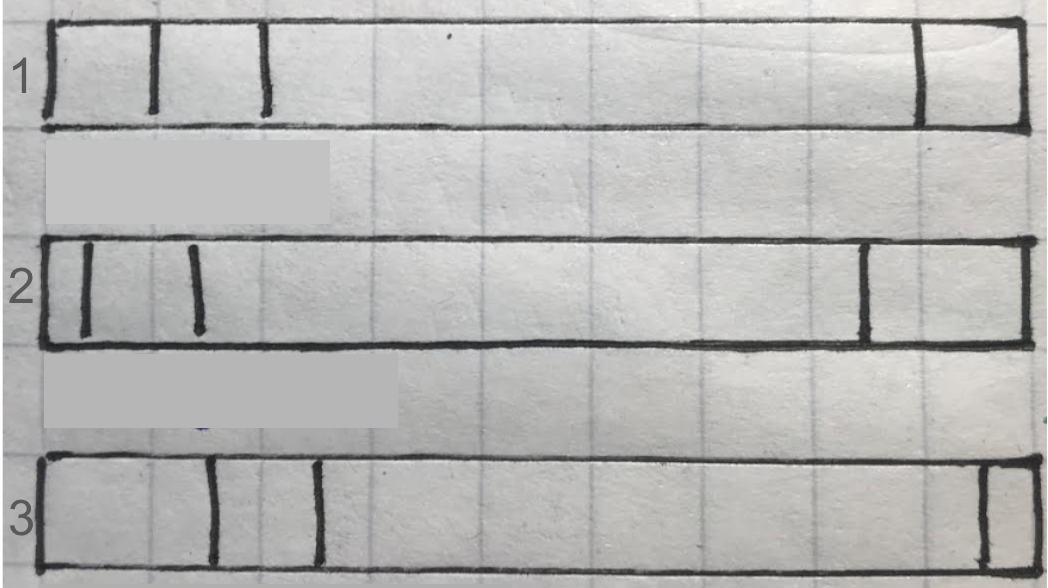
Label the diagram
Stationary
Moving away (Red-shifted)
Moving towards (Blue-shifted)
Parallax
The apparent shift in position of an object based on the location of the observer
What can we use to estimate the distance of far away objects fro Earth?
Parallax
How far apart should you measure E and E’
Six months apart (Half of Earth’s orbit)- to get the biggest possible baseline with maximal apparent shift (minimal error).

Explain the diagram
When an object is closer the more it seems to switch. The diagram shows the shift of the thumb in comparison to the clock.
S=
d/t
T=
d/s
D=
s x t
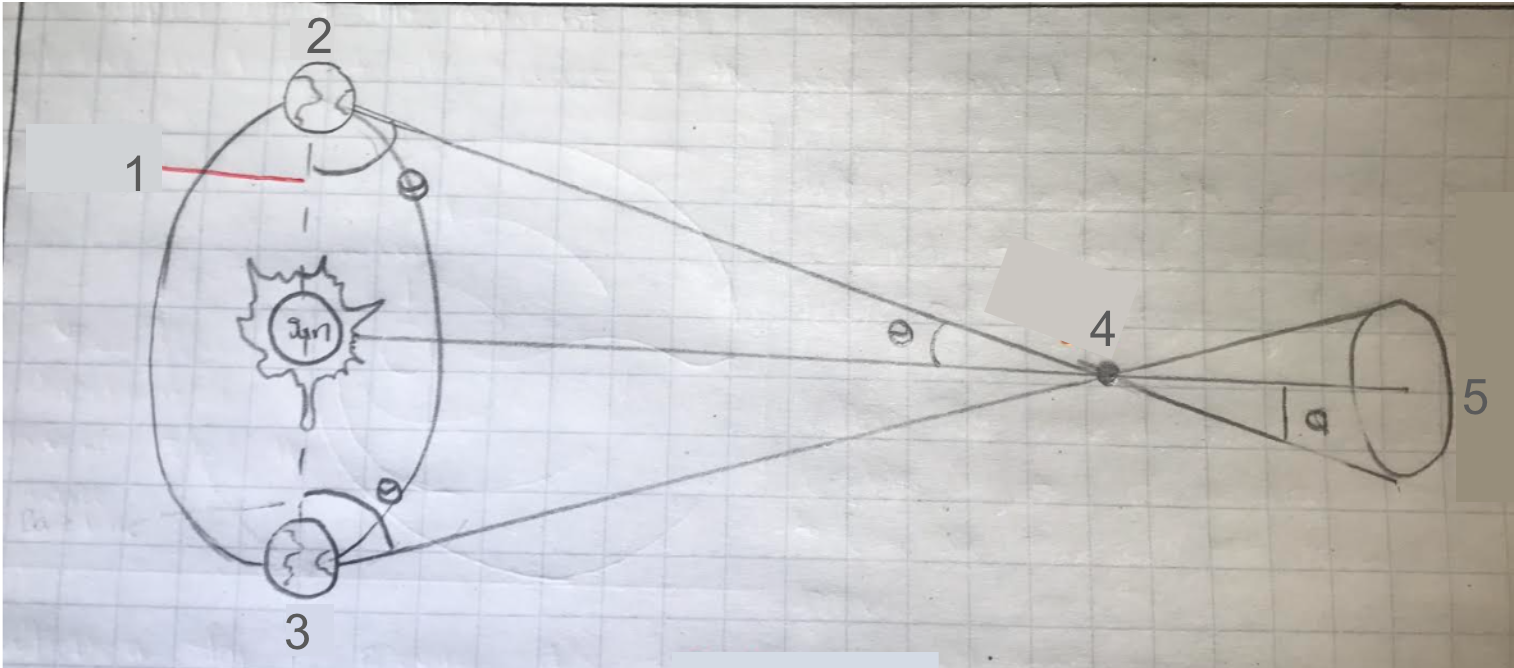
Label the diagram
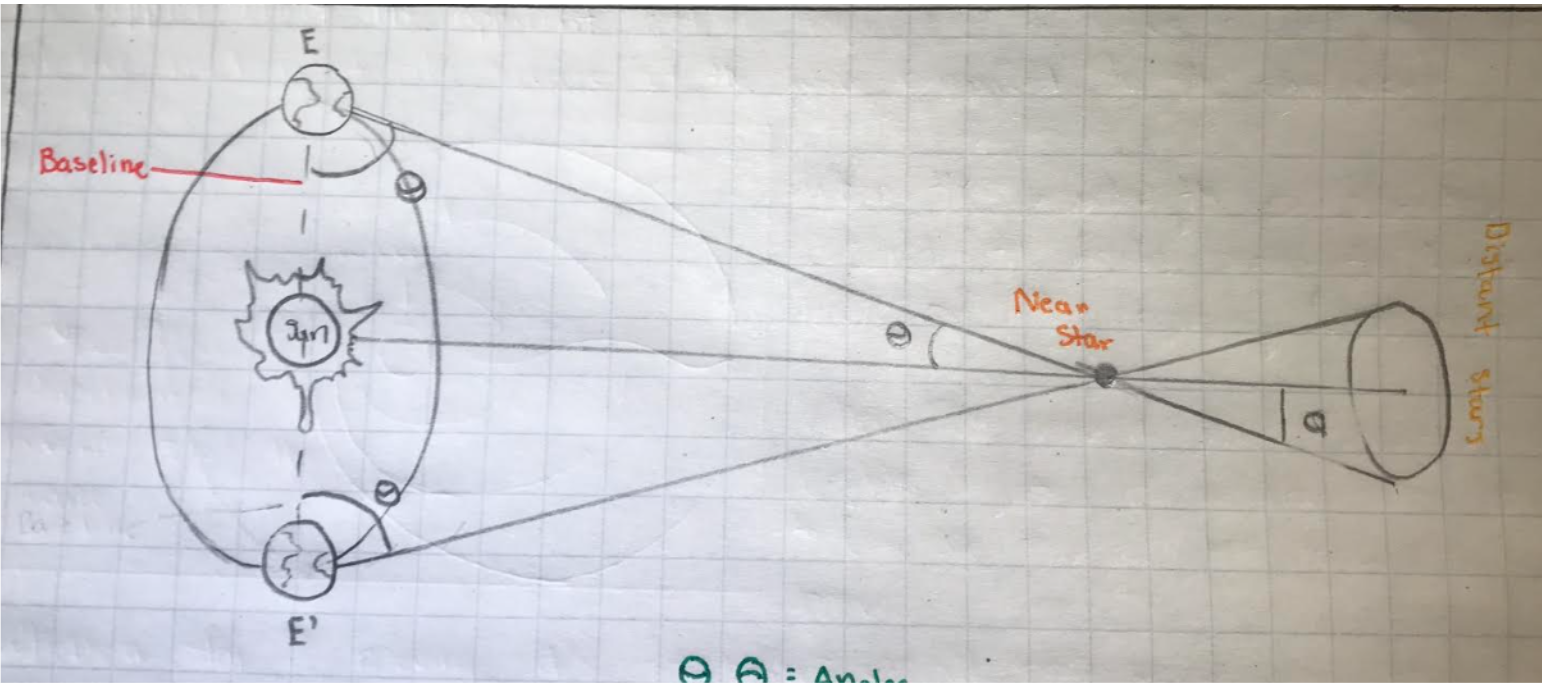
Astronomical units
(AU), 150 000 000km- Earth’s distance from the sun
Light year
63 241 AU- distance light travels in 1 year
What is triangulation
How you measure distance using parallax
Non-trigonometry
Create a baseline between the sides of the baseline and object
Measure the angles between the sides of the baseline and object
Draw a scaled diagram of the triangle you made
Calculate distance based on scale
Scale= Actual distance/Distance in diagram
Actual length= Measured distance x scale